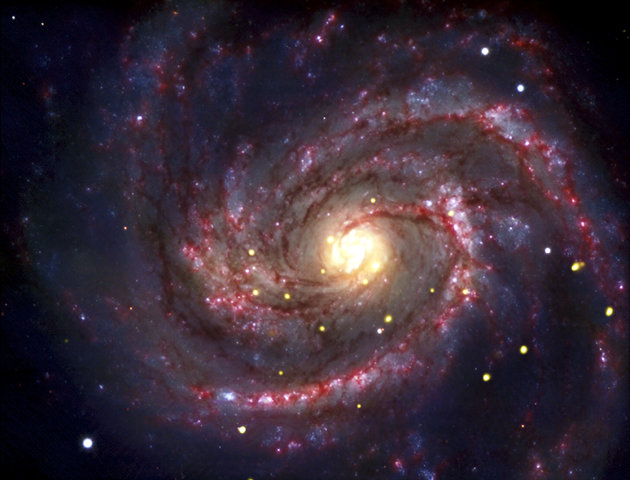 "I'm not perfect! Not yet.
"I'm not perfect! Not yet.
But I'm still leagues better than you."
-Weiss to Ruby, RWBY The Emerald Forest Pt.2
facebook •
deviantart •
twitter
tumblr •
weibo •
curecos •
worldcos
youtube •
soundcloud •
ask.fm •
instagram
MAORA. October 18th. Libra. Asian. Otaku. Sarcastic - Outspoken - a bit Psycho - Dense. Adores music and japanese entertainment. Speak Indonesian, American English and Japanese. Loves to eat rainbow, bunnies, watermelon, popsicle and other cute stuff. I don't bite often so be my guest.
 Lovely people!
Archives
Ask.fm

NO.6 Interactive Novel Project
on TUMBLR!
|
Baby photos from the ultimate edge black hole
written on October 25, 2011 ✈
Astronomers may have lucked into the ultimate in cosmic baby pictures: a voracious black hole fresh from its violent birth.
After watching a nearby star that exploded into a supernova in 1979, astronomers now believe the star's death wasn't an ordinary one. The star's explosion was big enough to cause a black hole to develop in its wake. They think it's a black hole because they see something steadily consuming the gassy remnants of the exploded star, which is a telltale sign of a black hole. It sucks up everything in sight.
And in this case it's a lot. In the past 30 years since this star exploded, this baby black hole has eaten about the equivalent of the Earth in mass, which is about as big as black hole appetites can get, said Harvard astrophysicist Avi Loeb. He's co-author of a new paper in the journal New Astronomy and he discussed the findings at a NASA news conference Monday.
On a cosmic scale the mass of the Earth is not an awful lot to eat, but from Earth's point of view, it's kind of awesome, said NASA astrophysicist Kimberly Weaver. "It's like the planet eater in 'Star Trek,'" she said.
Black holes are warped regions in space where it is so dense that nothing — not even light — escapes. Scientists in this case see energy bursts from matter as it is sucked in. That matter is heavy gas from the exploded star, and possibly a partner star that may have been next to it, Weaver said.
"It's the first time we're seeing a black hole being born in a normal supernova," Loeb said. "We're able to learn about environments that cannot be reproduced in the lab and can only be observed in the universe."

This composite image provided by NASA, created this month, taken by NASA's Chandra X-ray Observatory and other telescopes, shows a galaxy where a recent supernova probably resulted in a black hole in the bright white dot near the bottom middle of the picture.
While black holes are seen throughout the universe, it is unusual to witness one from near birth that "evolves and changes into its youthful stages," said Weaver. And unlike other black holes, thanks to the keen eye of a Maryland schoolteacher who witnessed the supernova in 1979, astronomers know exactly when this black hole was born, Weaver said.
By continuing to follow the black hole — which is about 50 million light years away — future astronomers will learn just how much material is left over from the star's explosion, said Dan Patnaude of Harvard, a study co-author. This black hole is about five times more massive than our sun and the star that exploded to give it birth was maybe 20 times bigger than our sun.
"This is certainly eating as much as it can," Patnaude said. "This is working as hard as it can to gobble up that material, exactly like a teenager or a toddler."
The images were captured by the Chandra X-Ray space telescope. There is one other possible explanation for what scientists have seen: They could be watching the birth instead of a pulsar wind nebula, like the famous and beautiful crab nebula. But Patnaude said a black hole is more likely.
Either way, this is a great chance to observe a cosmic event from the start, said Alex Filippenko of the University of California at Berkeley who didn't take part in the research. He agrees that the discovery is most likely a black hole.
...okay, it really scares me.Labels: entry, interest
|
Baby photos from the ultimate edge black hole
written on October 25, 2011 ✈
Astronomers may have lucked into the ultimate in cosmic baby pictures: a voracious black hole fresh from its violent birth.
After watching a nearby star that exploded into a supernova in 1979, astronomers now believe the star's death wasn't an ordinary one. The star's explosion was big enough to cause a black hole to develop in its wake. They think it's a black hole because they see something steadily consuming the gassy remnants of the exploded star, which is a telltale sign of a black hole. It sucks up everything in sight.
And in this case it's a lot. In the past 30 years since this star exploded, this baby black hole has eaten about the equivalent of the Earth in mass, which is about as big as black hole appetites can get, said Harvard astrophysicist Avi Loeb. He's co-author of a new paper in the journal New Astronomy and he discussed the findings at a NASA news conference Monday.
On a cosmic scale the mass of the Earth is not an awful lot to eat, but from Earth's point of view, it's kind of awesome, said NASA astrophysicist Kimberly Weaver. "It's like the planet eater in 'Star Trek,'" she said.
Black holes are warped regions in space where it is so dense that nothing — not even light — escapes. Scientists in this case see energy bursts from matter as it is sucked in. That matter is heavy gas from the exploded star, and possibly a partner star that may have been next to it, Weaver said.
"It's the first time we're seeing a black hole being born in a normal supernova," Loeb said. "We're able to learn about environments that cannot be reproduced in the lab and can only be observed in the universe."

This composite image provided by NASA, created this month, taken by NASA's Chandra X-ray Observatory and other telescopes, shows a galaxy where a recent supernova probably resulted in a black hole in the bright white dot near the bottom middle of the picture.
While black holes are seen throughout the universe, it is unusual to witness one from near birth that "evolves and changes into its youthful stages," said Weaver. And unlike other black holes, thanks to the keen eye of a Maryland schoolteacher who witnessed the supernova in 1979, astronomers know exactly when this black hole was born, Weaver said.
By continuing to follow the black hole — which is about 50 million light years away — future astronomers will learn just how much material is left over from the star's explosion, said Dan Patnaude of Harvard, a study co-author. This black hole is about five times more massive than our sun and the star that exploded to give it birth was maybe 20 times bigger than our sun.
"This is certainly eating as much as it can," Patnaude said. "This is working as hard as it can to gobble up that material, exactly like a teenager or a toddler."
The images were captured by the Chandra X-Ray space telescope. There is one other possible explanation for what scientists have seen: They could be watching the birth instead of a pulsar wind nebula, like the famous and beautiful crab nebula. But Patnaude said a black hole is more likely.
Either way, this is a great chance to observe a cosmic event from the start, said Alex Filippenko of the University of California at Berkeley who didn't take part in the research. He agrees that the discovery is most likely a black hole.
...okay, it really scares me.Labels: entry, interest
|
Web Mistress

♥ mao, maochi, momo, mao-chan, (add anything) :p♥
♥ Asian. Indonesian. ♥
♥ college student. freelance graphic designer. ♥
♥ tezukamaora@gmail.com ♥
♥ interest: ♥
web/fashion/graphic design. music. japanese pop entertainment/language/culture. cooking. anime. tokusatsu. cosplay.
♥ activities: ♥
work. college. band. cosplay. event organizing. making portfolio. costume making.
♥ figures: ♥
my mom. Momota Kanako. YUI. Sasazaki Mami. Sugiyama Noriaki. Emma Watson. Reika Arikawa. Mamegu. Mizuki Nana. Erika Sawajiri. Hosoya Yoshimasa. Yasumoto Hiroki.
♥ books: ♥
mallory tower. sherlock holmes. chicken soup series. eragon-eldest-brisingr-inheritance. totto-chan. torey hayden's. Steven King's. JRR Tolkien's. Little Prince. Classics. Sci-Fi.
♥ manga: ♥
miiko!. yotsuba&!. No.6. Naruto. Junjou Romantica. Beelzebub. Shin/Tenipuri. Magi. Sakamoto Desu ga.
♥ anime: ♥
KyoAni. Ghibli.
K-ON. Macross F. Hakuouki. Digimon series. Sekai-ichi Hatsukoi. Junjou Romantica. No.6. Shin/Tenipuri. Hoozuki no Reitetsu. Kimi to Boku. Naruto/Shippuden. Magi. Haikyuu!.
♥ music: ♥
Luna Sea. YUI. Momoiro Clover Z. SCANDAL. Macross songs. MUCC. L'arc~en~Ciel. The Gazette. Beyer. SID. Tommy heavenly6. Vanessa Mae. Paramore. After School. Do as Infinity. Uematsu Nobuo. Taylor Swift. SMTown. Houkago Tea Time. Avril Lavigne. Jam Project. Goosehouse. Aqua Timez. ZONE. Mandy Moore.
FAN OF:



















 









|
My Fun Projects
I'm not sure if I can finish all of this in a short period of time, and maybe not all of these will be made.
So this is a lifetime wishlist/project :)
grayscaled image are finished project











































|
Affiliates
|
Bookmarks
|
Banner / Button Exchange
|
































































































